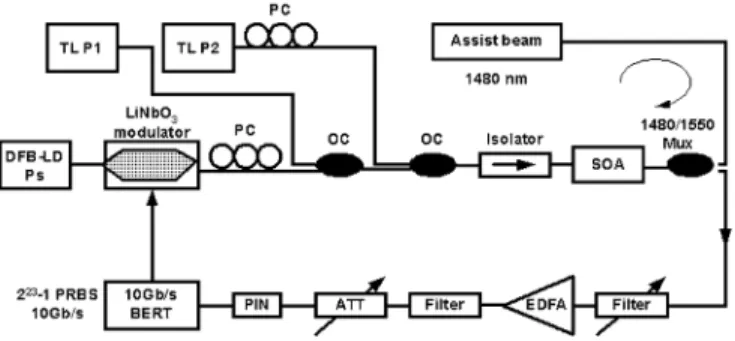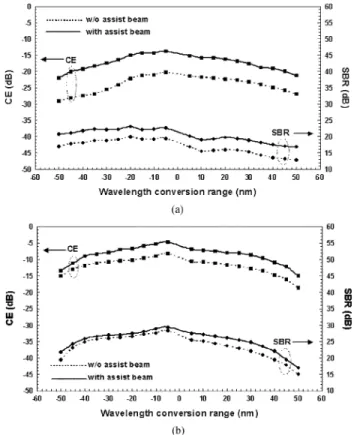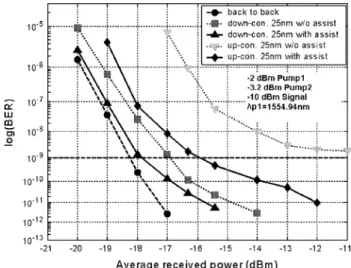IEEE PHOTONICS TECHNOLOGY LETTERS, VOL. 16, NO. 8, AUGUST 2004 1903
High-Efficiency Wide-Band SOA-Based Wavelength
Converters by Using Dual-Pumped Four-Wave
Mixing and an Assist Beam
Dar-Zu Hsu, San-Liang Lee, Pei-Miin Gong, Yu-Min Lin, Steven S. W. Lee, and Maria C. Yuang
Abstract—Wavelength conversion with a high efficiency and
wide conversion range can easily be realized by applying an assist beam of short wavelength to a dual-pumped semiconductor optical amplifier (SOA). Experimental results reveal that an assist beam can improve the conversion efficiency and signal-to-background ratio by up to 8.5 and 4.1 dB, respectively, when the SOA is biased at the current that makes the SOA transparent to the assist beam. The efficiency can exceed 10 dB over an 80-nm wavelength con-version range using a 23-dB gain SOA. The assist beam increases the system power budget because it simultaneously improves the conversion efficiency and reduces the receiver power penalty. The power penalties for up-converting and down-converting 10-Gb/s signals to 25 nm of wavelength range are less than 0.5 and 2.5 dB, respectively.
Index Terms—Assist beam, four-wave mixing (FWM),
fre-quency conversion, optical networks, semiconductor optical amplifier (SOA), wavelength conversion.
I. INTRODUCTION
W
AVELENGTH conversion by the four-wave mixing (FWM) effect in a semiconductor optical amplifier (SOA) typically has a poor efficiency and narrow conver-sion range. For practical applications, the signal-to-back-ground-noise ratio (SBR) and the wavelength conversion range of SOA-based FWM converters must be considerably improved. A high conversion efficiency is attainable from an SOA with very high gain [1], and the conversion range can be improved using dual-pump techniques [2], [3]. Although the use of two parallel polarized pumps can increase efficiency, the FWM conversion efficiency with two orthogonal polarized pumps (OPPs) is more uniform as the converted wavelength is varied. The wavelength conversion over 80 nm with nearly constant conversion efficiency was demonstrated using the OPP scheme and a 35-dB gain SOA [2]. However, the fiber-to-fiber Manuscript received June 13, 2003; revised April 5, 2004. This work was sup-ported by the National Science Council of the Republic of China under Contract NSC91-2213-E-011-074 and by the MOE Program of Excellence Research, Taiwan, R.O.C., under Contracts 89-E-FA04-1-4 and 89-E-FA06-2-4.D.-Z. Hsu, P.-M. Gong, Y.-M. Lin, and S. S. W. Lee are with the Com-puter and Communications Research Laboratory, Industrial Technology Research Institute, Hsinchu 310, Taiwan, R.O.C. (e-mail: sparkle@itri.org.tw; 910527@itri.org.tw; ymlin@itri.org.tw; swlee@itri.org.tw).
S.-L. Lee is with the Department of Electronic Engineering, National Taiwan University of Science and Technology, Taipei 106, Taiwan, R.O.C. (e-mail: sanlee@et.ntust.edu.tw).
M. C. Yuang is with the Department of Computer Science and Information Engineering, National Chiao Tung University, Hsinchu 300, Taiwan, R.O.C. (e-mail: mcyuang@csie.nctu.edu.tw).
Digital Object Identifier 10.1109/LPT.2004.829757
Fig. 1. Experimental setup. OC: Optical coupler. PC: Polarization controller. TL: Tunable laser.
gain of a commercial SOA is typically around 20 dB. The maximal gain is normally limited by amplified spontaneous emission (ASE) and the thermal effect. The conversion effi-ciency and SBR of the dual-pump scheme are still low without using an ultrahigh-gain SOA.
The proposed wavelength conversion method combines the advantages of the OPP scheme and an assist beam [4]. The as-sist beam yields high conversion efficiency and the OPP scheme provides a wide conversion range. This work demonstrates that using an assist beam in an SOA-based OPP-FWM converter considerably increases the conversion efficiency and SBR. This scheme is especially advantageous for up-conversion where the SBR is typically poor. Some reports have stated that a bit-error rate (BER) of less than is hard to achieve for a 15-nm up-conversion using a 24-dB gain SOA [5]. An assist beam can be used to yield a BER of less than for an up-conversion of up to 25 nm.
II. EXPERIMENTALSETUP ANDOPERATIONPRINCIPLES As depicted in Fig. 1, experiments were performed using a setup similar to that used to measure the SOA converter with a single pump and an assist beam [4]. The first pump beam (P1) is polarized parallel to the input signal (Ps), whereas, the second pump (P2) is orthogonally polarized. All Ps, P1, and P2 are combined and injected into an SOA with a small-signal gain of 23 dB. The input signal is modulated at 10 Gb/s using a LiNbO modulator with a pseudorandom sequence. The signal wavelength is fixed at 1555.75 nm and its power is 10 dBm. Two tunable lasers are used as P1 and P2 and their powers are set to 2 and 3.2 dBm, respectively. A 1480-nm assist beam with a power of 23.6 dBm is contra-directionally injected into the SOA. A 1.48/1.55- m multiplexer is applied at the output 1041-1135/04$20.00 © 2004 IEEE
1904 IEEE PHOTONICS TECHNOLOGY LETTERS, VOL. 16, NO. 8, AUGUST 2004
Fig. 2. Optical spectrum and definitions of wavelength conversion parameters.
end of the SOA to allow the injection of an assist beam and the output of the converted signal.
The detuning , defined as the difference between the wavelengths of P1 and Ps, is set to 0.8 nm during the exper-iments. The difference between the wavelengths of the con-verted signal and P2 equals the detuning , as indicated in Fig. 2. Therefore, the wavelength conversion range is
, where is the pump spacing, which is the difference between the wavelengths of P1 and P2. Fig. 2 refers to a case of down-conversion, in which the input signal is converted to a shorter wavelength. For up-conversion to a longer wavelength, the relative wavelength positions of Ps and P1 are the same as those for down conversion, but P2 resides at a longer-wave-length than P1. Accordingly, the wavelonger-wave-length conversion range for this case is .
When two orthogonal pumps are used, the conversion effi-ciency is determined mainly by the FWM between Ps and P1. The FWM efficiency is proportional to the unsaturated gain and to the square of the saturation power of an SOA [4]. Applying an assist beam has been shown to be able to increase the gain and/or saturation power of an SOA. The improvement varies with the SOA bias. A unique biasing condition of an SOA is the trans-parent condition to the assist beam, at which the presence of the beam does not change the gain of the SOA. The measured transparent current of the SOA for the 1480-nm assist beam is 100 mA. Under this condition, whenever the input beams (Ps, P1, and P2) deplete the carrier density and cause gain saturation, the assist beam is absorbed because the carrier density becomes lower than the transparent density. Excess carriers are gener-ated, preventing the gain medium from becoming saturgener-ated, so an assist beam can increase the saturation intensity. Even when the bias is well above the transparent condition, the assist beam can increase the saturation intensity due to the acceleration of the carrier dynamics. Hence, applying an assist beam can raise the conversion efficiency and the SBR of an OPP-based wave-length converter.
III. RESULTS ANDDISCUSSION
The FWM conversion efficiency and SBR of the converted signal was measured by sweeping the wavelength of P2. The conversion efficiency is defined as the ratio of the converted signal power to the input signal power. The SBR is obtained by dividing the converted signal power by the noise power within
Fig. 3. Effects of the assist beam on the conversion efficiency (CE) and SBR versus wavelength conversion range. (a) SOA is biased at 100 mA. (b) SOA is biased at 200 mA.
0.1 nm of optical bandwidth. When no assist beam is used, the conversion efficiency is mostly below 20 dB when the SOA is biased at 100 mA, as shown in Fig. 3(a). The conversion effi-ciency exceeds 20 dB for a conversion range of around 90 nm, when the assist beam is applied. The use of an assist beam in-creases the conversion efficiency by 5.5–8.5 dB and inin-creases the SBR by 2.7–4.1 dB. Biasing the SOA at a higher bias cur-rent can increase the conversion efficiency, but the assist beam provides less improvement. This is due to the fact that the SOA is operated in the gain regime of the assist beam and the presence of the assist beam increases the saturation intensity but reduces the amplifier gain. At a bias current of 200 mA, the conversion efficiency with the assist beam can exceed 10 dB for a con-version range of 80 nm, as shown in Fig. 3(b). The assist beam raises the conversion efficiency by better than 3 dB and SBR by 1.0 to 2.3 dB. Moreover, the results indicate that the peak efficiency and SBR can reach 5 and 30 dB, respectively. The enhancement of SBR is more pronounced in cases of up-con-version in which the original conup-con-version performance was rela-tively poor.
Fig. 4 depicts the performance improvement at various bias currents, due to the use of an assist beam. The enhancement de-clines as the bias increases, as explained previously. An SOA-based FWM wavelength converter is usually operated at the rated current to achieve the highest conversion efficiency and SBR. However, the SOA gain saturates at high bias, so simply increasing the current only slightly increases the efficiency. Op-erating an SOA at the rated current may shorten its lifetime. Fig. 4 reveals that biasing the SOA at 135 mA with an assist
HSU et al.: HIGH-EFFICIENCY WIDE-BAND SOA-BASED WAVELENGTH CONVERTERS BY USING DUAL-PUMPED FWM 1905
Fig. 4. Effects of an assist beam on the conversion efficiency (CE) and SBR versus SOA bias currents. The wavelength down-conversion range is 2.4 nm.
Fig. 5. Eye patterns for 25-nm down-conversion of 10-Gb/s signal without (left) and with (right) a 1480-nm assist beam. The SOA is biased at 200 mA.
beam can provide the same conversion efficiency and SBR as one biased at 200 mA without the assist beam. This finding sug-gests also that a greater enhancement may be attainable at a high bias current when an assist beam with a shorter wavelength is used, since the transparent current of such a beam is larger.
The eye diagram shown in Fig. 5 clearly indicates that the 1480-nm assist beam increases the signal amplitude by 3 dB and enlarges the eye opening. Fig. 6 plots the measured BER for both up- and down-conversion. The measurement is made by cascading at the output optical filters, an erbium-doped fiber amplifier, and an optical attenuator. The power penalties at a BER of are 1.4 and 0.5 dB for a down-conversion of 25 nm without and with the assist beam, respectively. The penalty arises from the effect of ASE and is typical for SOA-based wavelength converters. The up-conversion is well-known to have worse efficiency than the down-conversion [6], [7]. The results in Fig. 6 show that a BER of is hard to achieve for a 25-nm up-conversion without an assist beam because of the presence of an error floor. With the help of an assist beam, a BER of better than can be achieved with a power penalty
Fig. 6. Effects of the assist beam on BER at 10-Gb/s data rate for 25-nm down-and up-conversion. The SOA is biased at 200 mA.
of 2.5 dB for 25-nm up-conversion. An assist beam can reduce the power penalty because it increases the SBR.
IV. SUMMARY
This work has demonstrated that using an assist beam can in-crease the conversion efficiency and SBR of wide-band SOA wavelength converters. The conversion efficiency can be better than 10 dB over a wavelength conversion range of 80 nm, when an SOA with moderate gain is used. The BER measure-ment reveals that an assist beam can reduce the power penalty of a wavelength converter. The improvement is substantial for up-conversion and low BER. The use of an assist beam in the OPP-based wavelength conversion makes the scheme practical for system applications. The BER performance can be further improved using a higher gain SOA and/or a shorter wavelength assist beam.
REFERENCES
[1] A. D’Ottavi, F. Martelli, P. Spano, A. Mecozzi, and S. Scotti, “Very high efficiency four-wave mixing in a single semiconductor traveling wave amplifier,” Appl. Phys. Lett., vol. 67, pp. 2753–2755, 1995.
[2] T. J. Morgan, R. S. Tucker, and J. P. R. Lacey, “All-optical wavelength translation over 80 nm at 2.5 Gb/s using four-wave mixing in a semi-conductor optical amplifier,” IEEE Photon. Technol. Lett., vol. 11, pp. 982–984, Aug. 1999.
[3] I. Tomkos, I. Zacharopoulos, D. Syvridis, Th. Sphicopoulos, C. Caroubalos, and E. Roditi, “Performance of a reconfigurable wave-length convereter based on dual-pump-wave mixing in a semiconductor optical amplifier,” IEEE Photon. Technol. Lett., vol. 10, pp. 1404–1406, Oct. 1998.
[4] S. L. Lee, P. M. Gong, and C. T. Yang, “Performance enhancement on SOA-based four-wave-mixing wavelength conversion using an assist beam,” IEEE Photon. Technol. Lett., vol. 14, pp. 1713–1715, Dec. 2002. [5] A. D’Ottavi, P. Spano, G. Hunkziker, R. Paiella, R. Dall’Ara, G. Guekos, and K. J. Vahala, “Wavelength conversion at 10 Gb/s by four-wave mixing over a 30-nm interval,” IEEE Photon. Technol. Lett., vol. 10, pp. 952–954, July 1998.
[6] D. F. Geraghty, R. B. Lee, M. Verdiell, M. Ziari, A. Mathur, and K. J. Vahala, “Wavelength conversion for WDM communication systems using four-wave mixing in semiconductor optical amplifiers,” IEEE J. Select. Topics Quantum Electron., vol. 3, pp. 1146–1155, Oct. 1997. [7] T. Mukai and T. Saitoh, “Detuning characteristics and conversion
effi-ciency of nearly degenerate four-wave mixing in a 1.5-um travelling-wave semiconductor laser amplifier,” IEEE J. Select. Topics Quantum Electron., vol. 26, pp. 865–875, May 1990.


